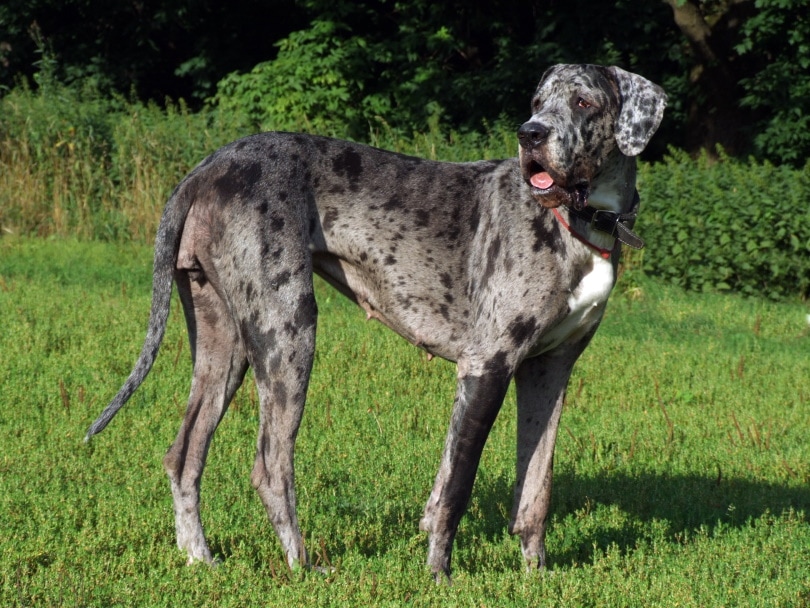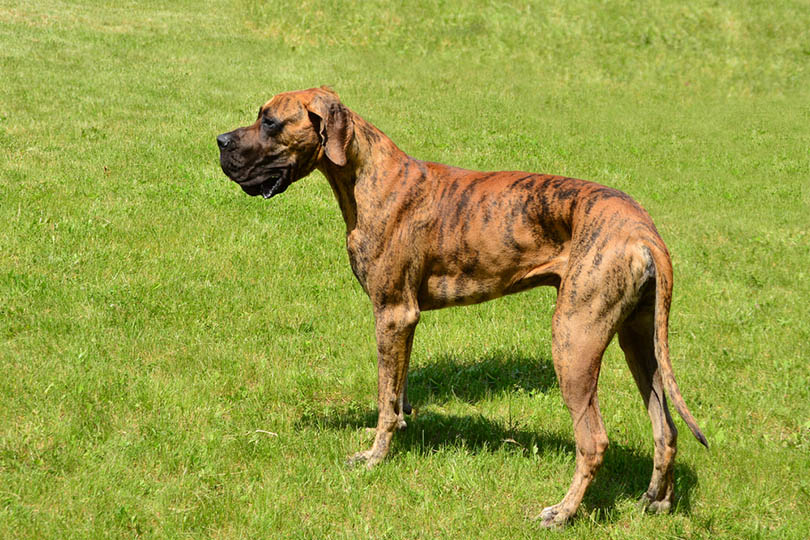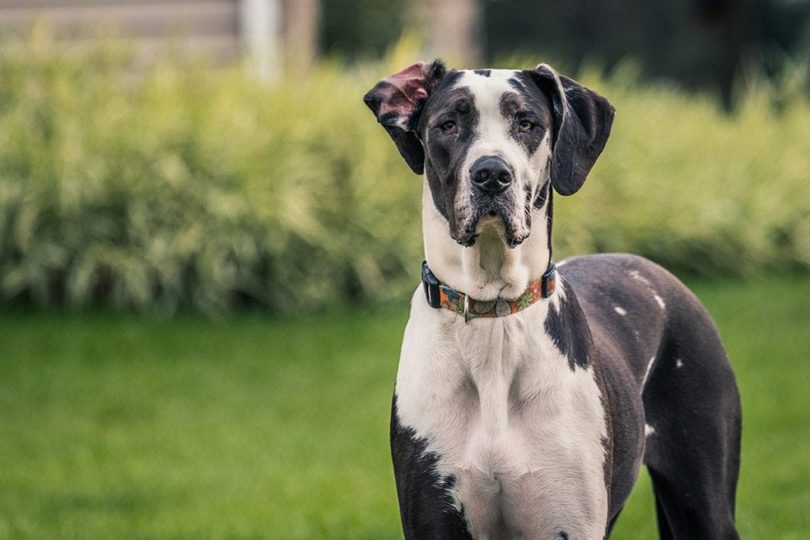Anyone who is interested in the Great Dane already knows that this breed is called the “Apollo of dogs”. Dog lovers are also aware that despite his impressive size (Great Danes are one of the largest dog breeds of all time, after all!), the appellation “gentle giant” is the one that best suits this magnificent animal. Back in the day in Europe, Great Danes were known for being fierce hunting companions.
But the origins of the Great Dane are a little more nebulous. So, you are surely wondering for what purpose this gigantic dog was bred, and where does he get his name from? Because, as the American Kennel Club so aptly puts it, this breed is indeed great, but not a Dane.

What Were Great Danes Bred For?
Originally, Great Danes were bred as hunting companions in Europe. They were eventually adopted by royalty and the upper-class elite for companionship and sport.
Today, Great Danes are most often bred as show dogs or wonderful family companions.

From Ferocious Hunters to Family Companions
In the 16th century, Great Danes were bred to hunt wild boars. However, their ancestors were very different from the gentle and affectionate dogs we know today. Indeed, the dogs chosen to be the companions of German and English hunters had to be above all strong, fast, and able to stand up to powerful beasts such as wolves, elk, and wild boars.
But, towards the end of the 19th century, the Great Dane was refined by breeders in Germany to match the high standards of the elite. The breeders especially wanted to improve the rather aggressive temperament of the Great Dane, which was a success.
Nevertheless, the arrival of the Great Danes in America remains a mystery. The Great Dane Club of America is known to have been founded in 1889, and the American Kennel Club considers it one of the oldest dog breeds.
Moreover, at the time, the Great Danes were called “English Mastiffs“. The exact origin of the breed is controversial, but they are believed to come from a mix of Mastiffs and Irish Wolf Hounds breeds.
A Name With Multiple Origins
As we’ve mentioned above, these splendid dogs were not always called Great Danes. They were first simply called Boar Hounds in the early 16th century, then Englische Docke, and finally Chamber Dogs (Kammerhunde, in German) in the early 17th century, when the German nobility began to take an interest in their skills as fabulous watch dogs.
In the late 1800s, a committee in Berlin changed the name of the Englische Docke to Deutsche Dogge, or German Mastiff. This laid the foundation from which the breed was developed.
Are you still confused about the exact origins of this breed’s name? You are not the only one!
In fact, no one really knows how or why the Great Danes, a German breed, became associated with Denmark. According to some authors, the official name Great Dane appeared somewhere in the 18th century, when a French naturalist traveled to Denmark and fell in love with one of these dogs. He reportedly took him home to France and called him Grand Danois, which means Great Dane in English.
By the way, these dogs are called Great Danes mainly in English-speaking countries: in Germany, France, and Canada, they are now mostly known as the Dogue Allemand (German dog).

Why Were Great Danes Such Good Hunters?
Looking at the friendly and affectionate character of the Great Dane today, it’s hard to believe they were such fierce hunters back then! Indeed, these gentle giants are lovable beasts that are easy to train and eager to please their beloved owners. However, Great Danes were formidable and aggressive hunting dogs at the time.
Let’s take a closer look at the two main characteristics of the Great Dane that have made him such a great hunter:
The Great Dane’s Body and Gait
The Great Dane has a powerful and well-proportioned body. His broad, deep chest, square shoulders, and well-pronounced sternum made him capable of standing up to large, dangerous beasts, such as wild boars and wolves. In addition, his athletic gait gave him agility and strength during the frantic races of the hunt. Not just any dog can go up against a boar, and the Great Dane was definitely up for it!

The Great Dane’s Massive Size
Obviously, the impressive size of the Great Dane cannot be overlooked. An adult male can measure up to 35 inches and weigh up to 200 pounds. If this huge beast were to chase you, you wouldn’t think twice before taking to your heels!
Great Danes Today
The Great Danes are a far cry from what they used to be. These dogs are the ultimate nanny dogs and can become great playmates for older children.
Thus, because of his appearance, the Great Dane has several great characteristics of a quality guard dog, thanks to his loud and powerful barks. He is also, above all, an excellent pet that is very attached to his owner and to his family to whom he only asks to please. If he receives a good education, the Great Dane will become the sweetest of dogs. Indeed, he is particularly sensitive to young children whose company he enjoys and for whom he is an unfailing protector. Moreover, the Great Dane accepts the presence of other dogs quite well, and even that of cats. On the other hand, he hates loneliness, but what dog is a fan of it anyway?

Final Thoughts
We hope this article has helped you learn more about this fascinating breed. It is true that its history and the origins of its name are not the easiest to follow, but this contributes to its aura of mystery and power. But one thing is certain, the Great Dane definitely has a place in our homes as a loving and protective four-legged friend!
See also:
- Great Dane Health Issues (Vet Answer): Common Problems to Watch For
- Pitbull vs Great Dane: The Differences (With Pictures)
Featured Image Credit: Earl Wilkerson, Shutterstock


















